Characteristics
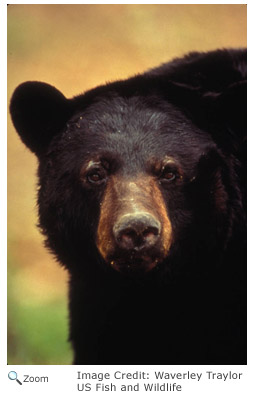 The American black bear is the smallest North American bear. It is usually black with a tan muzzle and a white patch on its chest. Black bears in the west may be cinnamon brown, and in parts of British Columbia and the Yukon Territory in Canada the black bear may even be silver-gray or white. The American black bear is the smallest North American bear. It is usually black with a tan muzzle and a white patch on its chest. Black bears in the west may be cinnamon brown, and in parts of British Columbia and the Yukon Territory in Canada the black bear may even be silver-gray or white.
The black bear has small, rounded ears and inch long claws on its feet. The black bear doesn't have a large shoulder hump like the brown, or grizzly bear. The black bear stands about three feet from shoulder to feet and it's 4-6 feet from head to toe. Males are usually much larger than females. The male usually weighs between 130 to 350 pounds, but it can weigh as much as 600 pounds. The female weighs 90 to 175 pounds.
Range
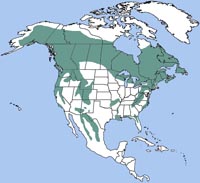 The black bear is found in most of Alaska southeastward through Canada to Minnesota, Wisconsin, Michigan, and the Canadian Maritimes and south through New England, New York, Pennsylvania, and the Appalachian Mountains to Florida. On the west coast, it is found south from Alaska through northern California and the Rocky Mountain states to Mexico. It is also found in Missouri, Arkansas, and Oklahoma. The black bear is found in most of Alaska southeastward through Canada to Minnesota, Wisconsin, Michigan, and the Canadian Maritimes and south through New England, New York, Pennsylvania, and the Appalachian Mountains to Florida. On the west coast, it is found south from Alaska through northern California and the Rocky Mountain states to Mexico. It is also found in Missouri, Arkansas, and Oklahoma.
Habitat
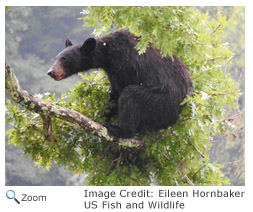 The black bear is found in a variety of habitats with tree-covered areas and meadows. It requires areas with lots of vegetation for cover and shrubs and other plants for food. It can be found in mountain areas, swamps, and forests. The black bear has a home range of about ten square miles. The home range of the male is usually larger than the home range of the female. The black bear is found in a variety of habitats with tree-covered areas and meadows. It requires areas with lots of vegetation for cover and shrubs and other plants for food. It can be found in mountain areas, swamps, and forests. The black bear has a home range of about ten square miles. The home range of the male is usually larger than the home range of the female.
|
|
Diet
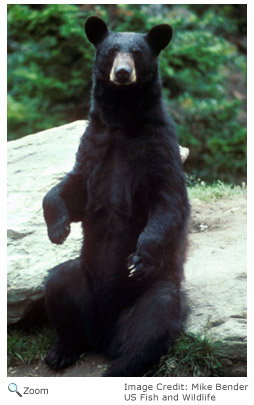 Although the black bear is in the carnivora order, it is really an omnivore, and most of its diet is made up of plants. It eats twigs, buds, leaves, nuts, roots, fruit, corn, and berries. It also eats bees and honey and it tears up rotting logs to get at grubs, beetles, and insects. The black bear also catches fish and small to medium-sized mammals. It also eats carrion. Although the black bear is in the carnivora order, it is really an omnivore, and most of its diet is made up of plants. It eats twigs, buds, leaves, nuts, roots, fruit, corn, and berries. It also eats bees and honey and it tears up rotting logs to get at grubs, beetles, and insects. The black bear also catches fish and small to medium-sized mammals. It also eats carrion.
In the summer, the black bear eats lots of foods that are rich in carbohydrates like berries. The black bear can gain as much as 30 pounds a week in the summer! It needs the extra weight to survive in the winter!
In the colder parts of its range, the black bear hibernates. It finds a place to spend the winter in a cave, under the roots of a fallen tree, in a crevice, in a hollow tree or log, or in a den it digs out. When it finds a place to hibernate, it curls up into a ball, places its head between its front paws, and goes to sleep! During hibernation, the black bear's heart beat slows to conserve energy. The black bear can be roused during hibernation, although it may take it a while for it to wake up! In the warmer parts of its range, the black bear can be active year-round..
Life Cycle
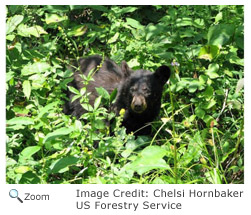 The black bear mates in June and July. The female gives birth to 1-5 cubs in January or February. The cubs are naked and blind at birth and weigh only 7 ounces! By the spring, the cubs weigh about ten pounds and begin to explore their environment with their mother. The cubs learn how to find food and survive from their mother during the spring, summer, and fall. The cubs are weaned when they are 6-8 months old, but they stay with their mother through the winter. In the spring, they leave to establish their own territory. The black bear mates in June and July. The female gives birth to 1-5 cubs in January or February. The cubs are naked and blind at birth and weigh only 7 ounces! By the spring, the cubs weigh about ten pounds and begin to explore their environment with their mother. The cubs learn how to find food and survive from their mother during the spring, summer, and fall. The cubs are weaned when they are 6-8 months old, but they stay with their mother through the winter. In the spring, they leave to establish their own territory.
Behavior
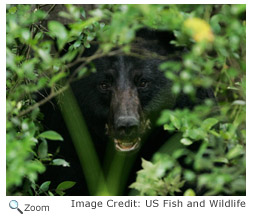 Except for during the mating season and when raising young, the black bear is a solitary animal. The black bear is usually crepuscular. That means it is active in the early morning and in the evening! It runs at speeds of up to 30 miles per hour and it is an excellent swimmer and tree climber. The black bear has poor eyesight, but it has an excellent sense of hearing and a keen sense of smell. Except for during the mating season and when raising young, the black bear is a solitary animal. The black bear is usually crepuscular. That means it is active in the early morning and in the evening! It runs at speeds of up to 30 miles per hour and it is an excellent swimmer and tree climber. The black bear has poor eyesight, but it has an excellent sense of hearing and a keen sense of smell.
|